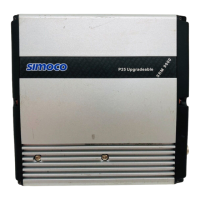DRAFT D
TNM-M-E-0001 Page 13
3. Technical Description
3.1 Receiver
Refer Figure 3-1
3.1.1 Front End Filters and RF Amplifier
The receiver input signal from the antenna passes through the antenna filter comprising L10,
L11, L12 and associated tuning capacitors. With the mobile in receive mode, diodes D3, D4 and
D5 in the antenna switch are reverse biased allowing the receiver input signal to be coupled
through to the front end with minimal loss. The overall insertion loss of the antenna filter and
switch is approximately 0.8dB. Front end selectivity is provided by varactor tuned bandpass
filters at the input and output of the RF amplifier.
Front end tuning voltages are derived from the alignment data stored in the radio. The DSP
processes this data to optimise front end tuning relative to the programmed channel frequencies
which may be changed at any time without re-aligning the radio.
To achieve the required varactor tuning range an arrangement of positive and negative bias
power supplies is used to provide a total bias across the varactors of up to 14.0VDC. A fixed
2.5V positive bias derived from the 5.0V supply and voltage divider R425/426 is applied to the
cathodes of the varactor diodes. The negative bias supply originates at the DSP/FPGA as a
composite digital tuning signal (FE TUNE) containing the data for the four front end tuning
values TUNE 1 to 4 for the particular channel frequency selected. The level is dependent on
channel frequency and tuning and varies between +0.1 and +3.0V. This signal then passes
through buffer U901A and level translator Q900 to Q903 where it is converted to a high level (-
0.5 to -11.5V) negative equivalent of the original signal. The -12.0V rail of the level translator is
generated by U300B/C with D304 to D306 providing the required voltage multiplier effect. The
high level negative signal is then split into the four individual front end negative DC values under
software control by multiplexer U902 and associated storage capacitors C904 to C907 before
being applied to the anodes of the front end tuning varactors.
The RF amplifier stage comprises a low noise transistor amplifier (Q400) which is compensated
to maintain good linearity across the required frequency bands and temperature range. This
provides excellent intermodulation and blocking performance across the full operating range.
The gain of this stage is typically 17dB for both UHF and VHF versions.
3.1.2 First Mixer and IF Section
The output of the last front end bandpass filter is coupled into single balanced mixer T400/D413
which converts the RF signal to an IF frequency of 45MHz. The local oscillator injection level is
typically +8dBm at T400 pin 1 with low side injection used for UHF and high side for VHF.
Following the mixer is IF amplifier Q401 which provides approximately 15dB of gain and in
association with its output circuitry presents the required load conditions to the 4 pole 45MHz
crystal filter Z401/402.

